A brutal four-game stretch starts Saturday with the Southwest Classic in Arlington. A Hog win would set up an absolutely monstrous date with Alabama next week, but let’s not get ahead of ourselves.
Meet the Aggies
Confused by any of the advanced stats you see here? Be sure to check out the glossary.
Texas A&M is 2-1. They beat Sam Houston 31-0, lost to Appalachian State 17-14, and then righted the ship last week against Miami, 17-9.
The data here is still about 30% from last year. That number will decrease to less than 20% after this weekend, and then drop out entirely after next weekend, once our 2022 sample size is large enough.

Model pick: Arkansas 28, Texas A&M 24.
The Aggies, as you are probably aware, have an excellent defense but a struggling offense. They’ve needed special teams help and good defense just get this far, and this far includes a home loss to a Sun Belt, albeit one of the Sun Belt favorites.
After two not-great games, Haynes King is out as starting quarterback. LSU transfer Max Johnson leads the Aggie attack. He was fine against Miami – 10 of 20 for 140 yards, with three sacks, three scrambles, and zero turnovers – but Aggie offensive issues go beyond quarterback, as we’ll see below. The defense is obviously very good but has some weaknesses.
Recent posts
- What Arkansas is getting in Nick Pringle and Malique Ewin
- Box Score Breakdown: Texas Tech 85, Arkansas 83
- Matchup Analysis: 3 Texas Tech
- Box Score Breakdown: Arkansas 75, St. John’s 66
- Matchup Analysis: 2 St. John’s
Scouting Report
The Aggie offense is a very conservative attack built around a power run game and short, rhythm passing game. It presents limited downfield threat. The backs and receivers are very talented, but the offensive line has struggled. Quarterback play is mediocre at best, though the jury is still out on new starter Max Johnson, and the scheme often puts him in tough situations.
The defense is a classic bend-don’t-break. It is elite at limiting big plays and is very good in the red zone, but it doesn’t get much pressure and doesn’t force many turnovers. The defensive line is big and athletic but not very active. The linebackers are excellent in coverage but have struggled with run fits at times. The secondary is very good all-around: downfield passing is an extreme challenge, and they tackle well in open space on the shorter stuff.
Special teams has been a lifesaver for A&M. The Aggies have a kickoff return touchdown, a muffed punt recovery, and a blocked field goal to their name. Their punter is one of the best in the nation at pinning opponents deep.
Three Names to Know
- Devon Achane. Replacing Isaiah Spiller is a tall task, and Achane has done admirably, while also adding a kickoff return touchdown. He has good vision and runs hard, even as the Aggie line has struggled. If the Hogs can contain him, the Aggies might forget about him, like Fisher did with Spiller last year in this game. But if he gets going, this could be a long night.
- Jaylon Jones. The Aggie secondary is very good, and Jones is one of the very good ones. The cornerback had eight solo tackles and two pass breakups against Miami.
- Edgerrin Cooper. Expect the Aggies’ weakside linebacker to play into Arkansas’ strategy. He’s been merely decent in his run fits, which could be an issue when Rocket Sanders flows runs to the backside. He has been excellent in pass coverage, but the Hogs might try to test him anyway.
When Arkansas has the ball
Defense has been a constant for Fisher’s first four seasons, thanks to the work of DC Mike Elko. Elko was rewarded last offseason with the head coaching job at Duke, so the Aggie defense is now coached by DJ Durkin, last seen turning around Ole Miss.
The DJ Durkin defense
Durkin has spent a lot of time around high-level programs. His break came working for Urban Meyer back when he was at Bowling Green. He was Meyer’s final DC at Florida and then Jim Harbaugh’s first DC at Michigan. He parlayed that into the Maryland head coaching job, which ended badly. Athlete Jordan McNair died of apparent heatstroke after collapsing at practice, and a subsequent investigation into the culture surrounding the program led to Durkin’s firing. He’s spent the last two seasons at Ole Miss under Lane Kiffin.
Durkin’s defenses are extremely multiple. At Florida, he ran a 4-3. At Michigan, a 3-4. And at Ole Miss, he ran a 4-2-5 in 2020 and then switched to a kind of 3-4 run with Dime personnel in 2021. At Fisher’s insistence, Durkin is running the same base 4-2-5 that Elko was running at Texas A&M this season.
Here’s a look at the current base alignment:

He can be described as a conservative coach. He favors man coverage and always keeps at least one safety deep. His defenses will run Quarters, Cover 1, and Cover 3 pretty much exclusively. He doesn’t call many blitzes, and when he does, they almost always come from the outside to the quarterback’s blind side.
The Aggies look a bit different up front, as well. As part of Durkin’s desire for defensive speed, he prefers smaller and faster linebackers. To keep them from getting overwhelmed by bigger blockers in the run game, he coaches his defensive line to “tie up” the offensive line (notice all the four-point stances in the above image). This frees up the linebackers to make plays. Arkansas does a lot of similar stuff under Barry Odom. The issue is that this causes the defensive line to be far less active. There are fewer run stuffs, and the Aggies are struggling to get pressure without blitzing. And as mentioned above, Durkin doesn’t blitz all that often. Keep that in mind as we look at the numbers.
So Durkin is certainly a bend-don’t-break coach, but the Aggie defense this year has been odd. On the one hand, they’ve allowed 0, 17, and 9 points in three games. But on the other, they’ve sprung an incredibly-weird leak. Here’s a section of the advanced stats recap of the A&M-App State game. See if you can see the oddity for App State’s offensive numbers:

You’re probably wondering: how did App State have such red topline numbers, yet put together long drives that pushed repeatedly into Aggie territory? And yeah — that’s the oddity. It’s quite weird to see. App State’s margin for error was basically zero. Their marginal third down conversion rate was +5% (their actual conversion rate was 5% better than we’d expect given the yards to go of each one) and their leverage rate was 69%, meaning that Texas A&M struggled to knock them off-schedule.
An advanced box score like that should be almost impossible to repeat. Except, here’s what happened against Miami:

It’s basically the same thing. The only difference is that Miami was held to three field goals in the red zone (1.5 points per scoring opportunity), while App State scored a couple of touchdowns. Miami still averaged almost nine plays per drive, gained more than half of the available yards, and saw two-thirds of their drives get inside the Aggie 40, all despite really poor per-play numbers. Like App State, the Hurricanes were good on third down (+9%) and didn’t have many negative plays.
So what has that done to the Aggies’ all-season numbers? Just gaze at this:

That is the most “bend-don’t-break” stat profile you will ever see. I mean, look at it. You couldn’t design a defense to be more bend-don’t-break than that.
The “bend” stats are things like plays per drive (Aggies are 130th out of 131), available yards (51st), and scoring chance percent (82nd). The “break” stats are, primarily, explosiveness, average starting field position, and points per scoring chance. Those deal with allowing opponents to finish drives or get yards without earning them. Texas A&M is 6th, 9th, and 3rd in those stats.
So the Aggies are bending a lot more than a team of their talent should, but they are absolutely elite at not breaking. As you can imagine, finishing drives is going to be key to this game. The Razorback offense should be able to eek out first downs here and there and compete in the field position battle, but the only chance to actually win is to turn promising drives into points.
So, what’s causing A&M to be so bendy on defense?

Third downs are a problem for the Aggies, which is one of the main reasons why opponents are able to keep drives afloat.
The Razorbacks are shedding explosiveness as the 2021 data continues to be diminished; this year’s team hasn’t shown that against FBS opposition. This game is unlikely to be a showcase for it: the Hogs’ best bet to string together lots of runs and short completions to stay ahead of the chains. As you can see, the Aggies are quite good against teams that try to get sneaky and throw passes on standard downs, but they are merely mediocre (66th) against teams that simply stay conservative and run the ball.

Only two red stats for A&M, but they are both important: opponents are successful in short yardage situations against them, and they don’t get many sacks. Both of those are relevant to keeping drives alive and staying on schedule.
As mentioned above, the Aggies will play a lot of man. Miami’s Tyler Van Dyke was 2 of 13 for 50 yards against man coverage last week, while App State’s Chase Brice was slightly better: 8 of 13 for 56 yards. Hog receivers, who have been wide open many times so far this year (especially on early down throws), will have the tall task of getting open.
The lack of sacks is a potential issue for the Aggies. As mentioned above, Durkin isn’t calling many blitzes, but his defensive line philosophy means the Aggies aren’t generating much pressure with four-man rushes either. Data from SIS shows that the Aggies managed to pressure Miami on just 21% of dropbacks and App State on just 23% (FBS average is 28%). The Razorbacks typically see high blitz rates – Cincinnati blitzed on almost half of Arkansas’ pass attempts – and giving KJ Jefferson tons of time to throw or scramble isn’t usually advisable.
On the flip side, vertical passing is very, very difficult against this defense. Miami even tried a flea flicker and it didn’t fool the Aggie safeties, who stayed put. Conservative safety play can be exploited by a good edge passing game, but that’s easier said than done:
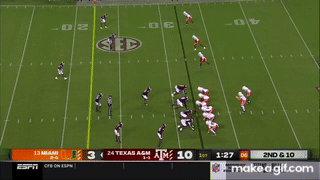
I’m not sure whether or not Arkansas will have success running the ball. App State had a 44% rushing success rate and Miami had 41% – both are better than the FBS average – and both had line yards per rush above the FBS average, with Miami’s 2.76 being really good. The reactionary A&M defense will seemingly have a hard time disrupting the run game, but if they successfully contain, it will whittle Arkansas’ margin for error to zero. To win, I think Kendal Briles will need to be aggressive with high-percentage passes on early downs, either via RPOs or called passes.
When Miami did have a burst of success with several consecutive successful read options, they pulled out the play action:
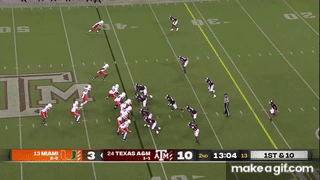
When A&M plays its Quarters (two-high safety) looks, Briles will bring out the RPOs and try to run between the tackles and hit some short, safe passes. This can create long drives that have little margin for error but also have few turnovers and win field position. If the Hogs get the run established, the Aggies will have to bring an extra defender into the box and play more Cover 1 or Cover 3. Texas A&M’s defense allows a lot of yards early in drives before tightening up as the ball gets closer to the end zone. The Hogs need to avoid early-drive mistakes, but if they finish drives well, this will probably be a victory.
When Texas A&M has the ball
Now that we’ve seen the green, get ready to see a lot of red for both sides.
Jimbo Fisher’s offense is known for its large playbook, pro-style concepts, and run-first balance. One of its most consistent features has been that it does not hit a lot of explosive passes. It is very conservative and rhythm-based. Because of this, the Aggies walk a fine line: they have to run well and maintain a high completion percentage in order to stay ahead of the chains.

Yikes! The Hogs are pretty bend-don’t-break: they force turnovers (23rd) and tighten up after the ball crosses midfield (19th). The “bending” stats are all there: 110th in plays per drive and 121st in scoring chances. The issue has been the explosive plays. For a proper bend-don’t-break approach, that figure should not be red. The Hogs will have a decent defense if they can get that number down.
For the Aggies, it’s been a ride. The offense’s awful starting field position (124th) is a direct result of their own defense bending so much (and not forcing turnovers). And that’s a problem for this offense, as it struggles to stay on the field: 125th in plays per drive, 115th in available yards, 113th in scoring chances. They don’t turn it over too much, and they hit some explosive plays every now and then, but the efficiency just isn’t there.
Jimbo Fisher’s playcalling has been scrutinized heavily, and there’s a reason for it.

About 16% of Aggie snaps are disrupted by a havoc play – that’s a turnover, sack, stuffed run, or pass breakup. Despite that, they do a nice job of staying on schedule (26th in leverage rate), but there’s a cost there.
They on schedule precisely because they are very predictable. Note the run rates: 59% on standard downs, just 16% on passing downs (129th). We can break it down further: against Miami, for example, the Aggies ran the ball on 75% of 1st-and-10s. If the run went well, they would often run again. If it didn’t, they would pass. Defenses can get a pretty good idea of what they want to do, which allows them to tee off.
They try to stay on-schedule because of those passing downs numbers: when this offense is off-schedule, it’s terrible. The Aggies are 126th in marginal third down conversions and 102nd in passing downs success rate. This game will pit bad-on-bad when it comes to the Aggie offense and the Razorback defense on passing downs.

The Aggie offensive line has been an adventure. They create their fair share of decent runs (9th in opportunity rate), but they’ve been horrific in short yardage (contributing to the awful third down numbers from above) and get stuffed in the backfield way too often.
Their best run play (by far) is a Counter, here with a guard and flex tight end pulling and star tailback Devon Achane cutting back:
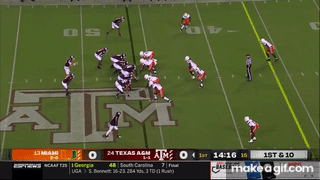
Two drives later, the Aggies tried to complement Counter with a Power run (back follows pulling guards), but a Miami defensive linemen forced Achane outside for a big gain:
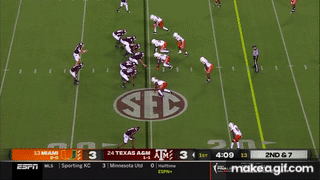
Miami eventually clamped down on this. The Aggies’ inside power/counter runs on their first five drives gained 5, 13, 3, 22, 1 (TD), 3, and 17. After that? 2, 1, 1, 11, and -4.
Bumper Pool had a rough coverage game against Missouri State, but he’ll be in his element defending against this kind of rushing attack. He needs a big game to keep Achane contained and keep the pressure on Max Johnson as a passer.
And while the Aggies were successful with the misdirection counter runs, their zone running game has been awful all season. The offensive line has struggled to keep linemen blocked:
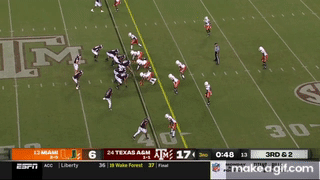
The theme of offensive line issues is a big one for Texas A&M. The Aggies have allowed sack rates of 8% and 11% over their last two games (FBS average = 6%) and pressure rates of 26% and 39% (FBS average = 28%). That 26% pressure rate against App State came even though the Mountaineers blitzed just two Aggie dropbacks all game.
Miami had to blitz 30% of dropbacks in order to get pressure, and the Aggies hurt them with swing passes, dumpoffs to the back, and a slip screen. But Johnson was not accurate down the field when the pocket collapsed, here against a four-man rush:
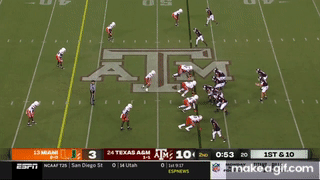
On the very next play, the four-man rush again forces the issue, and Johnson dumps it off. This is what the Hogs have to look out for.
Through three games, the Hogs lead the FBS in sacks with 17. The Hogs aren’t getting a ton of pressure, but more than 40% of Hog pressures are sacks. That’s… really high. Unfortunately, it’s probably unsustainably high. There’s likely to be some regression to the mean, where Arkansas continues to pressure at the same rate but the rate of sacks go down. If that could hold off for at least one more week, the Razorbacks would really appreciate that. If the Hogs manage to pressure the Aggies at the same rate Miami did and have the same sack/pressure ratio they’ve had through three games, we’re looking at five or six sacks for the defense. Given how badly the Aggies are when knocked off schedule, that might be enough to win the game.
Keys to the Game
Light ’em up. Arkansas’ only tool in its defensive toolbox at this point is the pass rush. The return of Myles Slusher should help on the back end, but the Aggies are a major threat to nickel-and-dime the Hogs to death with power runs and short passes. But A&M has struggled to protect its quarterback and struggles when it falls behind the chains. Barry Odom would probably prefer to not blitz and leave his secondary exposed, but the rush has to get there one way or another.
Win in the red zone. Anytime you face a bend-don’t-break defense, you have to finish promising drives with points. This was one of our keys against Cincinnati, and the Hogs delivered with 6.2 points per trip inside the 40. The Aggies have allowed a lot of drives inside their 40 – ten in the last two weeks – but have allowed just 26 points on them.
No freebies on special teams. The Aggies returned a kickoff for a touchdown against Appalachian State, set up a short touchdown thanks to a muffed punt against Miami, and also saw the Hurricanes miss two field goals (one blocked). The Aggies could easily be 1-2 with a two-possession loss to App State if not for special teams. There’s no good time to have a special teams meltdown, but this is a game where the Aggies will be desperate for the Razorback special teams to make a mistake.
The latest from Fayette Villains, straight to your inbox
Enter your email to subscribe and receive new post alerts and other updates. You can unsubscribe at any time.